Ethnic groups in Afghanistan

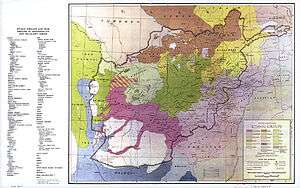
Afghanistan is a multiethnic society. The population of the country is divided into a wide variety of ethnolinguistic groups. The ethnic groups of the country are as follow: Pashtun, Tajik, Hazara, Uzbek, Aimak, Turkmen, Baloch, Pashai, Nuristani, Gujjar, Arab, Brahui, Pamiri and some others. The Afghan National Anthem mentions a total of 14 ethnic groups.
National identity
The term "Afghan" is synonymous with the ethnonym "Pashtun" and has been mentioned as early as the 3rd century, referring to the tribes inhabiting the lands south of the Hindu Kush around the Sulaiman Mountains. It became prominent during the Khilji, Lodi, and Suri dynasties of Northern India. The name became the national identity of Afghanistan in modern times.[1] Despite being of various ethnic groups, in a research poll that was conducted in 2009, 72% of the population labelled their identity as Afghan first, before ethnicity.[2]
While national culture of Afghanistan is not uniform, at the same time, the various ethnic groups have no clear boundaries between each other and there is much overlap.[3] Additionally, ethnic groups are not racially homogenous. Even though all ethnic groups in Afghanistan share a very similar culture, there are certain tradiditions and celebrations that each ethnic group has adopted from each other. For example, nowruz is the Persian New Year, which was originally celebrated by the Persians has now been adopted by some of the other groups. The attan which was originally a dance performed by Pashtuns, is now the national dance of Afghanistan.
Ethnic groups
Pashtun
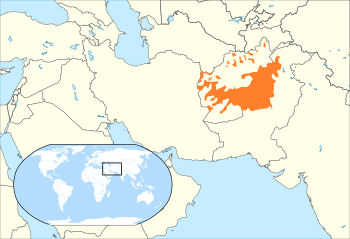
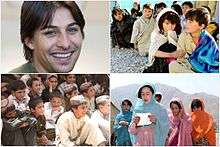
The Pashtuns (ethnic Afghans) make up the largest ethnic group in Afghanistan, comprising between 42% and 60% of the country's population.[4] Their main territory, sometimes called Pashtunistan, is between the Hindu Kush mountains in Afghanistan and the Indus River in neighboring Pakistan, where they are the second largest ethnic group. After the rise of the Hotaki dynasty in 1709 and the Durrani Empire in 1747, Pashtuns expanded by forming communities north of the Hindu Kush and elsewhere in Afghanistan.[5]
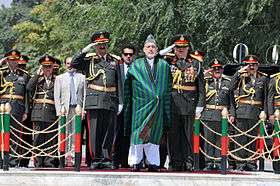
There are conflicting theories about the origin of the Pashtun people, both among historians and the Pashtun themselves. A variety of ancient groups with eponyms similar to Pukhtun have been hypothesized as possible ancestors of modern Pashtuns. The Greek historian Herodotus mentioned a people called Pactyans, living in the Achaemenid's Arachosia Satrap as early as the 1st millennium BC.[6] Since the 3rd century AD and onward they are mostly referred to by the ethnonym "Afghan", a name believed to be given to them by neighboring Persian people.[7] Some believe that ethnic Afghan is an adaptation of the Prakrit ethnonym Avagana, attested in the 6th century CE.[1] It was used to refer to a common legendary ancestor known as "Afghana", propagated to be grandson of King Saul of Israel.[8]
According to scholars such as V. Minorsky and others, the name Afghan appears in the 982 CE Hudud-al-Alam geography book. Al-Biruni referred to a group of Afghans in the 11th century as various tribes living on the western frontier mountains of Ancient India and Persia, which would be the area between the Hindu Kush mountains in Afghanistan and the Indus River in what is now Pakistan. According to other sources, some Pashtuns may be the Lost tribes of Israel who converted to Islam during the Arab Empire. Since the 13th century, some Pashtun tribes conquered areas outside their traditional Pashtun homeland by pushing deeper into South Asia, often forming kingdoms such as the Delhi Sultanate.[8]
The modern Afghan national identity developed in the mid 18th century under the rule of Ahmad Shah Durrani, who united all the tribes and formed the last Afghan empire.[9] Pashtuns are the traditional rulers of Afghanistan since the rise of the Hotaki dynasty in 1709 or more specifically when the Durrani Empire was created in 1747. They practice Sunni Islam and follow the Hanafi school of thought. The Karzai administration, which is led by Hamid Karzai, is dominated by Pashtun ministers.[10] In the 2014, Afghan presidential election, all of the eleven candidates were Pashtuns.
Some notable Pashtuns of Afghanistan include: Hamid Karzai, Ashraf Ghani, Nazo Tokhi, Akbar Khan, Ayub Khan, Malalai of Maiwand, Abdul Ahad Momand, Zalmay Khalilzad, the Afghan Girl, Hedayat Amin Arsala, Abdul Rahim Wardak, Sher Mohammad Karimi, Abdul Salam Azimi, Zalmai Rassoul, Omar Zakhilwal, Ghulam Farooq Wardak, Anwar ul-Haq Ahady, Daud Shah Saba, Mohammad Gulab Mangal, Gul Agha Sherzai, Asadullah Khalid, Mohammad Hanif Atmar, Mohammad Ishaq Aloko, Mohammed Omar, Gulbuddin Hekmatyar, Ahmad Zahir, Nashenas, Ubaidullah Jan, Naghma, Farhad Darya Nasher, Suhaila Seddiqi, Shukria Barakzai, Fauzia Gailani, the Hotakis, Durranis, Tarzis, Gailanis, Nashers, and Karzais. The monarchs of Afghanistan were all Pashtuns, except one who ruled for only ten months in 1932.
Tajik
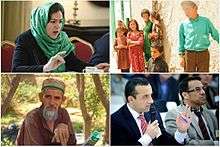
Tajiks form the second largest ethnic group in Afghanistan. They are a Persian-speaking people.[11] As a self-designation, the term Tajik, which earlier on had been more or less pejorative, has become acceptable only during the last several decades, particularly as a result of Soviet administration in Central Asia.[12] Alternative names for the Tajiks are Fārsī (Persian), Fārsīwān (Persian-speaker), and Dīhgān (cf. Tajik: Деҳқон, Dehqon, literally "farmer or settled villager", in a wider sense "settled" in contrast to "nomadic").[13] The Qizilbash are often included in sub-groups of the Tajiks, but according to some scholars, neither the Qizilbash nor the Farsiwan "can properly be called Tajiks."[11] The major difference between them is that Qizilbash and the Farsiwan are generally of the Shia sect, while the majority Tajiks practice Sunni Islam.
Like the rest of the ethnic groups in Afghanistan, the origin of Tajiks is a mystery. They were only able to rule and at the same time legitimize their rule as second- or even as immediate sub-rulers with some significant influence on the foreigners – with the exception of the short 10-month rule of Habibullah Kalakani in 1929.[14] The total number of Tajiks in Afghanistan was around 4.3 million in 1995,[15] and the Encyclopædia Britannica explains that by the early 21st century they constituted about one-fifth of the population.[11][16]
Tajiks are the major ethnic group in neighboring Tajikistan, a country that was created north of Afghanistan in 1991.[16] During the late 19th century and early 20th century, large number of Central Asian Tajiks fled the conquest of their native homeland by Russian Red Army and settled in northern Afghanistan.[17][18]
In Afghanistan, Tajiks are the majority in the city of Herat.[19] The city of Mazar-e-Sharif is 60% Tajik, Kabul is approximately 45% and Ghazni 50%.[19] Many are known to be in the Afghan National Security Forces (ANSF) while some in the major cities are bureaucrats, doctors, teachers, professors, traders, and shopkeepers. Others live in rural areas, particularly in Badakhshan, and engage in agriculture. The ethnic Tajiks are the closest rivals to Pashtuns for political power and prestige in Afghanistan. At the same time, they often engage in business partnerships and marriage contracts with each other. The Northern Alliance which opposed the Taliban government was dominated by Tajiks. Some notable Tajiks from Afghanistan include: Habibullah Kalakani, Burhanuddin Rabbani, Ahmad Shah Massoud, Ahmad Zia Massoud, Mohammed Fahim, Yunus Qanuni, Ismail Khan, Bismillah Khan Mohammadi, Atta Muhammad Nur, Amrullah Saleh, Wasef Bakhtari, Abdul Latif Pedram, Massouda Jalal, Baz Mohammad Ahmadi, Mohammed Daud Daud, Abdul Basir Salangi, and Fawzia Koofi.
Hazara
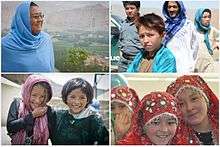
The Hazara is the third largest ethnic group in Afghanistan.[20] They are Persian-speaking and reside mainly in the Hazarajat region in central Afghanistan. The Hazaras seem to have partial Mongolian origins with admixture from surrounding indigenous, Iranian-speaking groups. Linguistically the Hazara speak a dialect of Persian, known as Hazaragi, and sometimes their variant is interspersed with Mongolian words. It is commonly believed that the Hazara are descendants of Genghis Khan's army, which invaded Afghanistan during the 12th century. Proponents of this view hold that many of the Mongol soldiers and their family members settled in the area and remained there after the Mongol empire dissolved in the 13th century, converting to Islam and adopting local customs. Most of the Hazaras practice Shia Islam, while most of the other Afghans are Sunni. Hazaras living in Afghanistan were estimated in 1995 at about one million[15] and now they are between 6 [21] to 7 million.
Some notable Hazaras of Afghanistan include: Karim Khalili, Habiba Sarabi, Sarwar Danish, Sima Samar, Ramazan Bashardost, Abdul Haq Shafaq, Sayed Anwar Rahmati, Qurban Ali Oruzgani, Azra Jafari, Abdul Ali Mazari, Mohammad Mohaqiq, Rohullah Nikpai, Hamid Rahimi, and Fariba Rezayee.
Uzbek
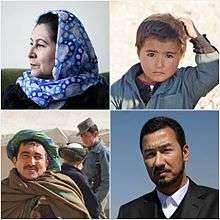
The Uzbeks are the main Turkic people of Afghanistan whose native territory is in the northern regions of the country. Most likely the Uzbeks migrated with a wave of Turkic invaders and intermingled with local Iranian tribes over time to become the ethnic group they are today. By the 16th century the Uzbeks had settled throughout Central Asia and reached Afghanistan following the conquests of Muhammad Shaybani. The Uzbeks of Afghanistan are Sunni Muslims and fluent in Uzbek.[22] Uzbeks living in Afghanistan were estimated in the 1990s at approximately 1.3 million[15] but are now believed to be 2 million.[23]
Some notable Uzbeks of Afghanistan include: Abdul Rashid Dostum, Husn Banu Ghazanfar, Abdul Rouf Ibrahimi, Muhammad Yunus Nawandish, Sherkhan Farnood, Abdul Malik Pahlawan and Rasul Pahlawan.
Aimaq
Aimaq, meaning "tribe" in Turkic (Oymaq), is not an ethnic denomination, but differentiates semi-nomadic herders and agricultural tribal groups of various ethnic origins including the Tajik, Hazara and Baluch, that were formed in the sixteenth and seventeenth centuries. They live among non-tribal people in the western areas of Badghis, Ghor and Herat provinces. They are Sunni Muslims, speak dialects of the Persian language close to Dari, and refer to themselves with tribal designations.[24] Population estimates vary widely, from less than 500,000 to around 800,000.
Turkmen
The Turkmen are the smaller Turkic group. They are Sunni Muslims, and their origins are very similar to that of the Uzbeks. Unlike the Uzbeks, however, the Turkmen are traditionally a nomadic people (though they were forced to abandon this way of life in Turkmenistan itself under Soviet rule).[22] In the 1990s their number was put at around 200,000.[15]
Baloch
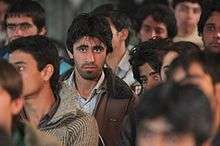
The Baloch people are speakers of Balochi who are mostly found in and around the Balochistan region of Afghanistan. In the 1990s their number figure was put at 100,000 but they are around 200,000 today.[15] They are most likely an offshoot of the Kurds and reached Afghanistan sometimes between 1000 and 1300 BCE. Mainly pastoral and desert dwellers, the Baloch are also Sunni Muslim. Abdul Karim Brahui Governor of Nimruz Province, is Baloch.
Nuristani
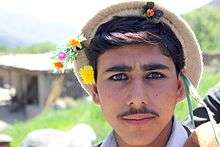
The Nuristani are an Indo-Iranian people, representing a fourth independent branch of the Aryan peoples (Indo-Aryan, Iranian, Nuristani, and Dardic), who live in isolated regions of northeastern Afghanistan as well as across the border in the district of Chitral in Pakistan. They speak a variety of Nuristani languages. Better known historically as the Kafirs of what was once known as Kafiristan (land of pagans), they converted to Islam during the rule of Amir Abdur Rahman and their country was renamed "Nuristan", meaning "Land of Light" (as in the light of Islam). A small unconquered portion of Kafiristan inhabited by the Kalash people who still practice their pre-Islamic religion still exists across the border in highlands of Chitral, northwestern Pakistan. Many Nuristanis believe that they are the descendants of Alexander the Great's ancient Greeks, but there is a lack of genetic evidence for this and they are more than likely an isolated pocket of early Aryan invaders. Physically, the Nuristani are of the Mediterranean sub-stock with about one-third recessive blondism.[22] They follow Sunni Islam like most of the other Afghans. The population in the 1990s was estimated at 125,000 by some; the Nuristani prefer a figure of 300,000.[15]
Smaller groups
Smaller groups include Pashai, Pamiri, Kyrgyz, Arabs, Punjabis and Gujjar.
Ethnic composition

As of 2013, the total population of Afghanistan is 27.5 million,[25] with additional three million or so temporarily living in neighboring Pakistan and Iran as part of the Afghan diaspora. The government began issuing computerized ID cards in which the ethnicity of each citizen is to be provided in the application.[26] This process is expected to reveal the exact figures about the size and composition of the various ethnic groups living in the country.[27]
An approximate distribution of the ethnic groups is shown in the chart below:
| Ethnic group | World Factbook / Library of Congress Country Studies (2004-present estimate)[28][29] | World Factbook / Library of Congress Country Studies (pre-2004 estimates)[15][30][31] |
|---|---|---|
| Pashtun | 42% | 38-50% |
| Tajik | 27% | 25-26.3% (of this 1% is Qizilbash) |
| Hazara | 9% | 12-19% |
| Uzbek | 9% | 6-8% |
| Aimak | 4% | 500,000 to 800,000 individuals |
| Turkmen | 3% | 2.5% |
| Baloch | 2% | 100,000 individuals |
| Others (Pashai, Nuristani, Arab, Brahui, Pamiri, Gujjar, etc.) | 4% | 6.9% |
The above 2004–present suggested estimations are some what supported by recent national opinion polls, which were aimed at knowing how a group of about 804 to 7,760 local residents in Afghanistan felt about the current war, political situation, as well as the economic and social issues affecting their daily lives. Seven of the surveys were conducted between 2004 and 2012 by the Asia Foundation and one between 2004 and 2009 by a combined effort of the broadcasting companies NBC News, BBC, and ARD.[2][32]
To one specific question at the end of the long questionnaires, "which ethnic group do you belong to?", the results of the 804 to 7,760 Afghans showed as:
| Ethnic group | "Afghanistan: Where Things Stand" (2004–2009)[2] | "A survey of the Afghan people" (2006)[32] | "A survey of the Afghan people" (2007)[32] | "A survey of the Afghan people" (2008)[32] | "A survey of the Afghan people" (2009)[32] | "A survey of the Afghan people" (2010)[32] | "A survey of the Afghan people" (2011)[32] | "A survey of the Afghan people" (2012)[32] |
|---|---|---|---|---|---|---|---|---|
| Pashtun | 38-46% | 40.9% | 40% | Not reported | Not reported | 42% | 41% | 40% |
| Tajik | 37-39% | 37.1% | 35% | " | " | 31% | 31% | 33% |
| Hazara | 6-13% | 9.2% | 10% | " | " | 10% | 11% | 11% |
| Uzbek | 5-7% | 9.2% | 8% | " | " | 9% | 9% | 9% |
| Aimak | 0-0% | 0.1% | 1% | " | " | 2% | 1% | 1% |
| Turkmen | 1-2% | 1.7% | 3% | " | " | 2% | 2% | 2% |
| Baloch | 1-3% | 0.5% | 1% | " | " | 1% | 1% | 1% |
| Others (Pashayi, Nuristani, Arab, etc.) | 0-4% | 1.4% | 2% | " | " | 3% | 3% | 5% |
| No opinion | 0-2% | 0% | 0% | " | " | 0% | 0% | 0% |
See also
References
- 1 2 Kieffer, Ch. M. "Afghan". Encyclopædia Iranica.
From a more limited, ethnological point of view, “Afḡān” is the term by which the Persian-speakers of Afghanistan (and the non-Paṧtō-speaking ethnic groups generally) designate the Paṧtūn. The equation Afghans = Paṧtūn has been propagated all the more, both in and beyond Afghanistan, because the Paṧtūn tribal confederation is by far the most important in the country, numerically and politically.
- 1 2 3 ABC NEWS/BBC/ARD POLL – AFGHANISTAN: WHERE THINGS STAND, February 9th, 2009, p. 38–40
- ↑ Peter R. Blood, ed. Afghanistan: A Country Study. Washington: GPO for the Library of Congress, 2001.
- ↑ See:
- "Afghan Population: 31,108,077 (July 2013 est.) [Pashtun = 42%]". Central Intelligence Agency (CIA). The World Factbook. Retrieved 7 June 2013.
- "Ethnic groups". BBC News. Retrieved 7 June 2013.
Pashtun: Estimated to be in excess of 45% of the population, the Pashtuns have been the most dominant ethnic group in Afghanistan.
- Janda, Kenneth; Jeffrey M. Berry; Jerry Goldman (2008). The Challenge of Democracy: Government in America (9 ed.). Cengage Learning. p. 46. ISBN 0-618-81017-X. Retrieved 2010-08-22.
- "Afghanistan's complex ethnic patchwork". The Asian Wall Street Journal. Tehran Times. March 10, 2011. Retrieved 20 April 2012.
- "Pathans". Faqs.org. 2003. Retrieved 2010-09-20.
- "About Afghanistan - Ethnic Divisions". Retrieved 2010-09-24.
- Christensen, Asger (1995). Aiding Afghanistan: the background and prospects for reconstruction in a fragmented society. NIAS Press. p. 46. ISBN 87-87062-44-5. Retrieved 2010-09-24.
- Congressional Record. Government Printing Office. p. 10088. Retrieved 2010-09-24.
- Taylor, William J. Jr.; Abraham Kim (2000). Asian Security to the Year 2000. DIANE Publishing. p. 58. ISBN 1-4289-1368-8. Retrieved 2010-09-24.
- Brown, Keith; Sarah Ogilvie (2009). Concise encyclopedia of languages of the world. Elsevie. p. 845. ISBN 0-08-087774-5. Retrieved 2010-09-24.
Pashto, which is mainly spoken south of the mountain range of the Hindu Kush, is reportedly the mother tongue of 60% of the Afghan population.
- Hawthorne, Susan; Bronwyn Winter (2002). 11 September 2001: feminist perspectives. Spinifex Press. p. 225. ISBN 1-876756-27-6. Retrieved 2010-09-24.
Over 60 percent of the population in Afghanistan is Pashtun ...
- "The ethnic composition of afghanistan in different sources". Retrieved April 22, 2012.
- ↑ "Ethnic map of Afghanistan" (PDF). Thomas Gouttierre, Center For Afghanistan Studies, University of Nebraska at Omaha; Matthew S. Baker, Stratfor. National Geographic Society. 2003. Retrieved 24 October 2010.
- ↑ Chapter 7 of The History of Herodotus (trans. George Rawlinson; originally written 440 BC) (retrieved 10 January 2007)
- ↑ "Afghan and Afghanistan". Abdul Hai Habibi. alamahabibi.com. 1969. Retrieved 2010-10-24.
- 1 2 "Pashtun". Encyclopædia Britannica. Retrieved 2011-03-21.
- ↑ "Afghanistan". CIA World Factbook. Retrieved 2011-03-21.
- ↑ "Afghan Government 2009" (PDF). Central Intelligence Agency. Southern Center for International Studies. September 28, 2009. Retrieved 2011-03-21.
- 1 2 3 Perry, John (July 20, 2009). "TAJIK i. THE ETHNONYM: ORIGINS AND APPLICATION". Encyclopædia Iranica. Retrieved 2014-04-10.
- ↑ C.E. Bosworth; B.G. Fragner (1999). "TĀDJĪK". Encyclopaedia of Islam (CD-ROM Edition v. 1.0 ed.). Leiden, The Netherlands: Koninklijke Brill NV.
- ↑ M. Longworth Dames; G. Morgenstierne; R. Ghirshman (1999). "AFGHĀNISTĀN". Encyclopaedia of Islam (CD-ROM Edition v. 1.0 ed.). Leiden, The Netherlands: Koninklijke Brill NV.
- ↑ Richard S. Newell "Post-Soviet Afghanistan: The Position of the Minorities". Asian Survey, Vol. 29, No. 11 (Nov., 1989), pp. 1090–1108. Publisher: University of California Press
- 1 2 3 4 5 6 7 "Ethnic Groups". Library of Congress Country Studies. 1997. Retrieved 2010-10-08.
- 1 2 "Tajik". Encyclopædia Britannica. Retrieved November 6, 2011.
There were about 5,000,000 in Afghanistan, where they constituted about one-fifth of the population.
- ↑ Wörmer, Nils (2012). "The Networks of Kunduz: A History of Conflict and Their Actors, from 1992 to 2001" (PDF). Stiftung Wissenschaft und Politik. Afghanistan Analysts Network. p. 8. Retrieved 2014-04-10.
While non-Pashtun settlers from inside Afghanistan such as Tajiks, Hazara or Baluch people moved to Kataghan during the late nineteenth and early twentieth century as well, the most considerable wave of non-Pashtun immigration to the northeast occurred in the 1920s. By this time between one-and two-hundred thousand Tajiks and Uzbeks fled the conquest of their homeland by Russian Red Army and settled in northern Afghanistan
- ↑ "Afghanistan: Glossary". British Library. Retrieved 15 March 2008.
tajiks An ethnic minority group migrated from former Russian Turkestan, ethnically and linguistically Persian, residing north of the Hindu Kush and around Kabul
- 1 2 "2003 National Geographic Population Map" (PDF). Thomas Gouttierre, Center For Afghanistan Studies, University of Nebraska at Omaha; Matthew S. Baker, Stratfor. National Geographic Society. 2003. Retrieved 2011-04-11.
- ↑ "HAZĀRA". Arash Khazeni, Alessandro Monsutti, Charles M. Kieffer. Encyclopædia Iranica. December 15, 2003. Retrieved 2014-04-10.
- ↑ "Hazara". Encyclopædia Britannica. Retrieved November 6, 2011.
- 1 2 3 "Afghanistan: (iv.) ethnocgraphy". L. Dupree. Encyclopædia Iranica. July 1982. Retrieved 2014-04-10.
- ↑ "Uzbek,". Encyclopædia Britannica. Retrieved 2011-11-06.
- ↑ Library of Congress, Aimaq
- ↑ http://www.pajhwok.com/en/2013/04/30/afghan-population-set-reach-275m-year
- ↑ Ghulam Hussain Zakiri, ed. (February 24, 2013). "14m Afghans to get computerised ID cards in a year". Pajhwok Afghan News. Retrieved 2013-05-04.
- ↑ Abasin Zaheer, ed. (May 26, 2013). "Senators stress caution in ID cards issuance". Pajhwok Afghan News. Retrieved 2013-05-04.
- ↑ "Ethnic groups: Pashtun 42%, Tajik 27%, Hazara 9%, Uzbek 9%, Aimak 4%, Turkmen 3%, Baloch 2%, other 4%". The World Factbook. Central Intelligence Agency (CIA). Retrieved 2010-09-18.
- ↑ "Country Profile: Afghanistan" (PDF). Library of Congress Country Studies on Afghanistan. August 2008. Retrieved October 10, 2010.
- ↑ "The World Factbok – Afghanistan". The World Factbook/Central Intelligence Agency. University of Missouri. October 15, 1991. Retrieved 2011-03-20.
_#_Ethnic divisions: Pashtun 50%, Tajik 25%, Uzbek 9%, Hazara 12-15%; minor ethnic groups include Chahar Aimaks, Turkmen, Baloch, and other
- ↑ "PEOPLE – Ethnic divisions:". The World Factbook/Central Intelligence Agency. University of Missouri. January 22, 1993. Retrieved 2011-03-20.
Pashtun 38%, Tajik 25%, Uzbek 6%, Hazara 19%; minor ethnic groups include Chahar Aimaks, Turkmen, Baloch, and others
- 1 2 3 4 5 6 7 8 See:
- "Afghanistan in 2012 – A survey of the Afghan people" (PDF). Kabul, Afghanistan: The Asia Foundation. pp. 181–182. Retrieved 2012-11-28.
Appendix 1: Target Demographics 181... Pashtun 40%, Tajik 33%, Uzbek 9%, Hazara 11%, Turkmen 2%, Baloch 1%, Nuristani 1%, Aimak 1%, Arab 2%, Pashaye 1%, Sadat 1%
- "Afghanistan in 2011 – A survey of the Afghan people" (PDF). Kabul, Afghanistan: The Asia Foundation. p. 251. Retrieved 2012-11-13.
15. Appendix 3: Interview Questionnaire... D-10. Which ethnic group do you belong to? SINGLE RESPONSE ONLY Pashtun 41%, Tajik 32%, Uzbek 9%, Hazara 11%, Turkmen 5%, Baloch 1%, Nuristani 1%, Aimak 1%, Arab 1%, Sadat 1%
- "Afghanistan in 2010 – A survey of the Afghan people" (PDF). Kabul, Afghanistan: The Asia Foundation. 2010. pp. 225–226. Retrieved 2011-03-20.
D-9. Which ethnic group do you belong to? SINGLE RESPONSE ONLY Pashtun 42%, Tajik 31%, Uzbek 9%, Hazara 10%, Turkmen 2%, Baloch 1%, Nuristani 1%, Aimak 2%, Arab 2%
- "Afghanistan in 2009: A Survey of the Afghan People" (PDF). Kabul, Afghanistan: The Asia Foundation. Retrieved 2012-11-28.
The 2009 survey interviewed 6,406 Afghans (53% men and 47% women)
- "Afghanistan in 2008 – A survey of the Afghan people" (PDF). Kabul, Afghanistan: The Asia Foundation. Retrieved 2012-11-28.
The 2008 survey interviewed 6,593 Afghans...
- "Afghanistan in 2007 – A survey of the Afghan people" (PDF). Kabul, Afghanistan: The Asia Foundation. 2010. pp. 225–226. Retrieved 2011-03-20.
The 2007 survey interviewed 6,406 Afghans, Which ethnic group do you belong to? SINGLE RESPONSE ONLY Pashtun 40%, Tajik 35%, Uzbek 8%, Hazara 10%, Turkmen 3%, Baloch 1%, Nuristani 1%, Aimak 1%, Arab 1%
- "Afghanistan in 2006 – A survey of the Afghan people" (PDF). Kabul, Afghanistan: The Asia Foundation. pp. 83–88. Retrieved 2012-11-28.
A total of 6,226 respondents were surveyed in the study, out of which 4888 (78.5%) were from the rural areas and 1338 (22%) were from the urban areas. Ethnicity: Pashtun 40.9, Tajik 37.1, Uzbek 9.2, Hazara 9.2, Turkmen 1.7, Baloch 0.5, Nuristani 0.4, Aimak 0.1, Arab 0.7, Pashayi 0.3
- "Afghanistan in 2004 – A survey of the Afghan people" (PDF). Kabul, Afghanistan: The Asia Foundation. 2004. Retrieved 2012-11-28.
The 2004 survey interviewed 804 Afghans, Which ethnic group do you belong to? Pashtun 46%, Tajik 39%, Uzbek 6%, Hazara 6%, Turkmen 1%, Baloch 0%, Nuristani 1%, Aimak 0%, Arab 1%, Pashaye 0%, Other 1%.
- "Afghanistan in 2012 – A survey of the Afghan people" (PDF). Kabul, Afghanistan: The Asia Foundation. pp. 181–182. Retrieved 2012-11-28.
External links
- Enmity Breeds Violence in Afghanistan by Nabi Sahak